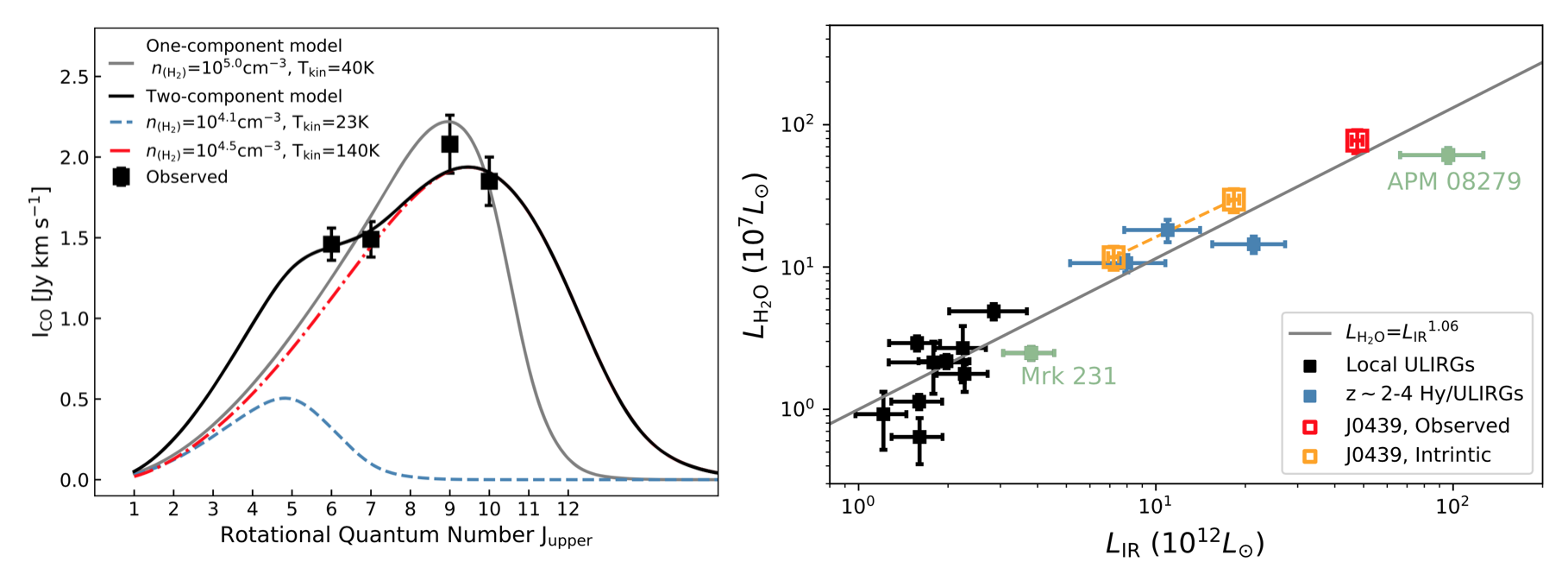Far-infrared Properties of the Bright, Gravitationally Lensed Quasar J0439+1634 at z=6.5

From our new z ~ 7 quasar survey, we discovered the most distant lensed quasar J0439+1634 at z = 6.5188 with high magnification m = 51.3 in
the optical (Fan et al. 2019, ApJL, 870,11), the first such object at the reionization epoch. This quasar is the brightest quasar known at
z > 6, with J = 17.4 mag (AB).
The Far-infrared (FIR) follow-up observations show that this quasar is also the FIR brightest one at z > 6. The strong lensing makes
J0439+1634 be the unique probe of the properties of quasar and host galaxy at such early Universe.
With IRAM/NOEMA, JCMT/SCUBA-2, and VLA observations, we detect strong dust emission, [CII]158 μm, [CI] 369 μm, [OI] 146 μm,
CO(6-5), CO(7-6), CO(9-8), CO(10-9), H2O 3 1,2-22,1, and H2O 32,1-31,2 lines
as well as a weak radio continuum. Lensing magnification makes J0439+1634 the far-infrared (FIR) brightest quasar at z > 6 known,
with the brightest [CII] line yet detected at this redshift.
The FIR luminosity is (3.4±0.2) × 1013 μ-1 L⊙, where μ ∼ 2.6 - 6.6 is the magnification of the host galaxy, estimated based on the lensing configuration from HST imaging.
We estimate the dust mass to be (2.2±0.1)×109 μ-1 M⊙.
The spatially unresolved [CII] line places a first order estimate on the dynamical mass and constrains the ratio of
MBH/Mdyn ∼ 0.011 - 0.036, consistent with previous results for z ≳ 6 quasars and above the typical value for local galaxies.
The fluxes of four CO lines are best fit by a two-component model of the molecular gas excitation. The estimates of molecular gas mass derived from CO lines and atomic carbon mass are consistent, in the range of 3.9 - 8.9 ×
1010 μ-1 M⊙.
The [CII]/[CI], [CII]/CO, and [OI]/[CII] line luminosity ratios can be explained with a photodissociation region model with a radiation field G ∼ 103-4 and a high gas density n ∼ 105-5.5 cm-3.
The ratio of H2O 32,1-31,2 line luminosity to LTIR is consistent with values in local and high redshift ultra-/hyper-luminous infrared galaxies.
The VLA observations indicate that J0439+1634 is radio quiet with radio loudness R = 0.05 - 0.17.

• Yang, Jinyi, Venemans, Bram, Wang, Feige, et al. 2019,
ApJ Far-infrared Properties of the Bright, Gravitationally Lensed Quasar J0439+1634 at z = 6.5
• Fan, Xiaohui, Wang, Feige, Yang, Jinyi, et al. 2019,
ApJL
The Discovery of a Gravitationally Lensed Quasar at z = 6.51